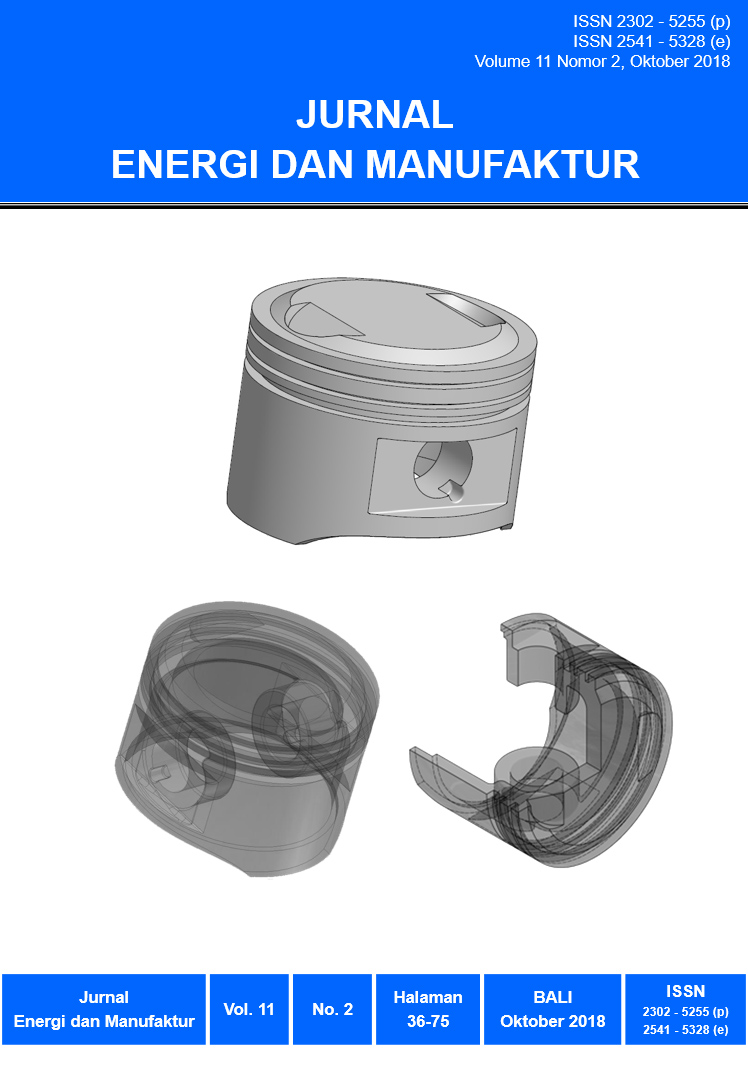Analisis Airfoil Double-Slot Flap LS(01)-0417 MOD Dengan Airfoil Tanpa Flap Nasa SC(2) 0610
Abstract
Kestabilan pesawat terbang ditentukan oleh desain airfoil sayap dan ekor. Perbedaan kecepatan aliran udara antara permukaan atas dan bawah airfoil menghasilkan perbedaan tekanan sehingga akan memberikan gaya angkat (lift) pada sayap. Perbedaan tekanan udara pada permukaan sayap dinyatakan dengan pressure coefficient (Cp), yaitu perbedaan tekanan statik lokal dengan tekanan statik aliran bebas. Koefisien lift (Cl) adalah rasio antara gaya angkat (lift) dengan tekanan dinamis. Peningkatan angka CL sebesar 20,4% pada riset sebelumnya diperoleh berdasarkan simulasi penambahan flap. Tujuan penelitian ini adalah membandingkan hasil simulasi airfoil double slot flap LS(01)-0417 MOD dengan airfoil NASA SC(2) 0610 yang tanpa flap dan mencari korelasi antara sudut serang (?) dengan koefisien lift (Cl ).Metodologi penelitian dilakukan dengan simulasi Computational Fluid Dynamic (CFD). Hasil penelitian dapat disimpulkan bahwa koefisien lift CL untuk airfoil double slot flap LS(01)-0417 MOD menghasilkan CL = 1,498 sedangkan dengan sudut serang ? = 16o sedangkan airfoil NASA SC(2) 0610 tanpa flap memiliki nilai CL = 1,095 dengan sudut serang 13o.
The stability of the aircraft is ordered by the airfoil design of the wings and the tail. The difference in flow velocity between the surface and the bottom of the airfoil will produce styles that will present lift on the wings. The difference in airflow velocity between the top and bottom surfaces of the airfoil produces a pressure difference so it will provide lift (lift) on the wing. The lift coefficient (CL) is the ratio between lift with dynamic pressure. The difference of air pressure on the wing surface is expressed by pressure coefficient (Cp), the difference of local static pressure with free flow static pressure. The lift coefficient (Cl) is the ratio of lift to dynamic pressure. An increase in CL value of 20.4% in previous research was obtained based on the simulation of flap addition. The purpose of this research is comparison between airfoil double slot flap LS (01)-0417 MOD with airfoil NASA SC (2) 0610 without flap and search between angle of attack (?) with coefficient of lift (Cl). Method research is done by Computational Fluid Dynamic (CFD). The result of this research can be concluded that lift coefficient CL for double slot airfoil flap LS (01)-0417 MOD yield CL = 1,498 while with angle of attack ? = 16o while airfoil NASA SC (2) 0610 without flap have value CL = 1,095 with angle of attack 13o
Downloads
References
[2] Yuda Benharry Tangkilisan, 2011, Kebijakan Penerbangan Perintis di Indonesia: Latar Belakang, Tantangan, dan Kontribusi, Paradigma, Jurnal Kajian Budaya, Naskah Hasil Penelitian Hibah Strategis Nasional DRPM UI 2010 untuk Penerbitan Paradigma FIB UI.
[3] Garg, P. Sony, N. 2016, Aerodynamic Investigation of Flow Field Over NACA 4415 Airfoil, International Journal of Advanced Research in Science, Engineering and Technology, Vol. 3, Issue 2.
[4] Prabhakar, A. Ayush Ohri, A. CFD Analysis on MAV NACA 2412 Wing in High Lift Take-Off, Aeronautics & Aerospace Engineering, Department of Mechanical and Manufacturing Engineering, Manipal Institute of Technology, Karnataka, India. [http://dx.doi.org/10.4172/2168-9792.1000125]
[5] Sari, M. 2018, Optimasi Coeffisient Lift (Cl) Single Slotted Flap dan Double Slotted Flap Pada Pesawat N219 Menggunakan Simulasi Computational Fluid Dynamics, Skripsi, FT-UNEJ.
[6] Gunadi, R. 2010. Simulasi Aliran Lewat Airfoil dengan Slotted Flap menggunakan Metode Vorteks. Jurnal Politeknologi.9(3): 35-44
[7] Gede, S. I. dkk.. 2014. Pengaruh Fixed Leading Edge Slot terhadap Karakteristik Airfoil Simetris dengan variasi Sudut Serang. Jurnal Ilmiah Teknik Desain Mekanika.3(6): 61-69
[8] Roskam, J. Lan, C, T, E. 1997, Airplane Aerodunamics Performance, DARcorporation, Lawrance, Kasnsas, USA
[9] Kevadiya, M. 2013, CFD Analysis of Pressure Coeffisient for NACA 4412
[10] Li, D, 2013, Multi-Objective Design Optimation For High-Lift Aircraft Configurations Supported by Surrogate Modeling, Cranfield University.
[11] Patel, K, S. Patel, S, B. Patel, U, B. Ahuja, A, P. 2014, CFD Analysis of an Aerofoil, International Journal of Engineering Research, Vol.3, Issue 3, pp: 154-158.
[12] Saiz, R, L. 2016, Final Approach and Landing
Trajectory Generation for Civil Airplane in Total Loss of Thrust, Dipartamento di Ingegneria Aerospaziale, Università di Pisa

This work is licensed under a Creative Commons Attribution-NonCommercial-ShareAlike 4.0 International License.









